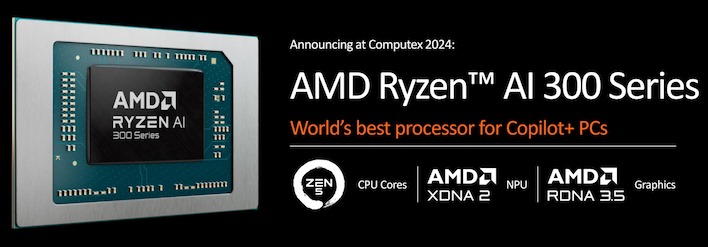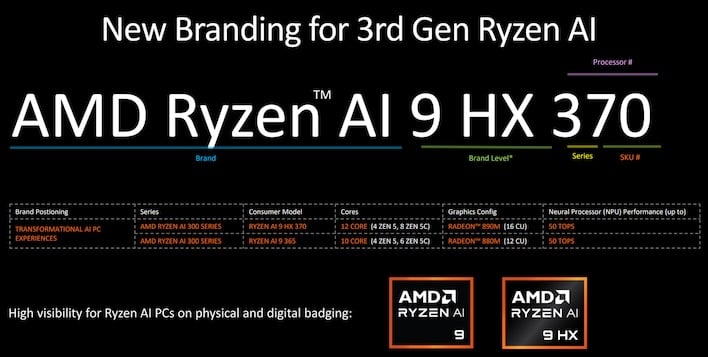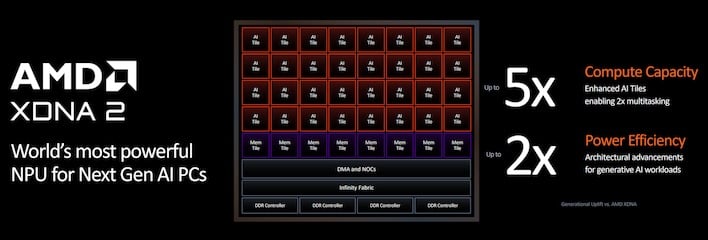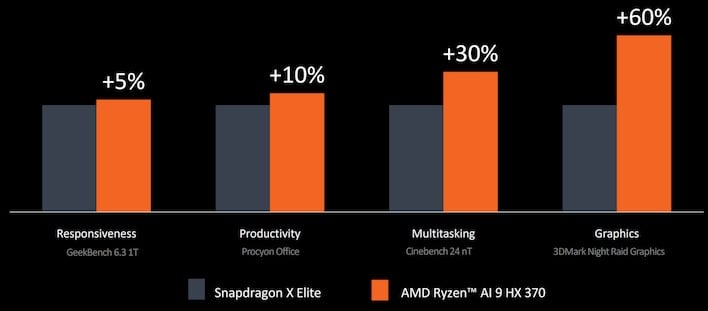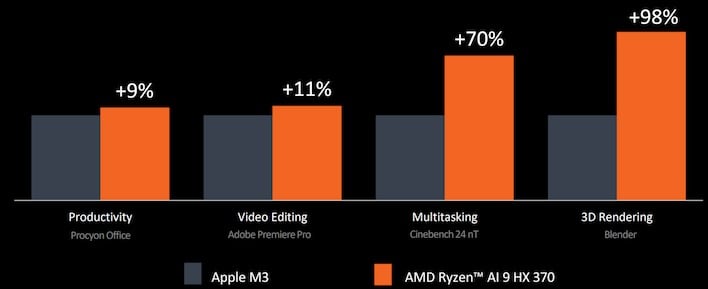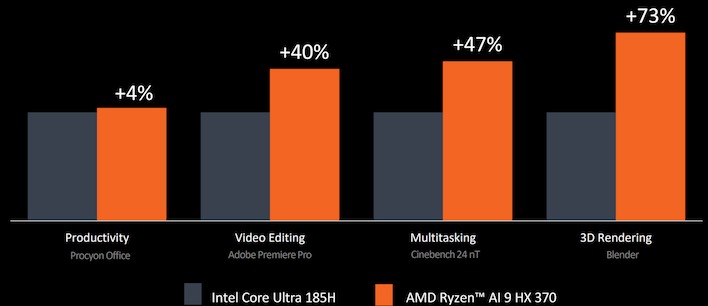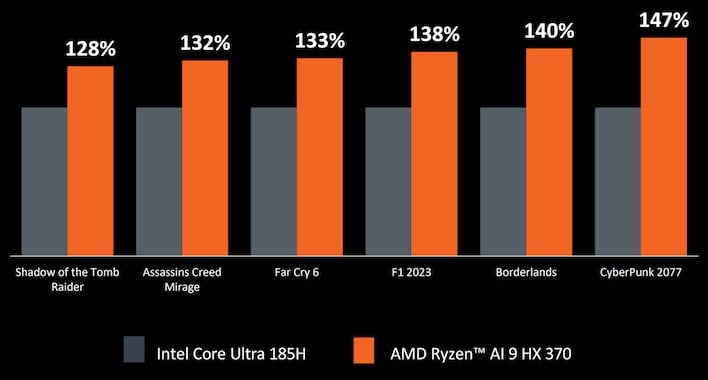AMD Supercharges Copilot+ AI PCs With Ryzen AI 300 Mobile CPUs, 50 TOPS NPU On Board
That's the justification for the new model naming convention, by the way. These upcoming Ryzen mobile processors are the third generation of NPU-equipped chips from AMD. The first were the Ryzen 7040 "Phoenix" chips, and the second were the Ryzen 8040 "Hawk Point" processors that quickly followed. So, now we're looking at the third generation, the Ryzen AI 300 series, codenamed Strix Point.
Introducing The AMD Ryzen AI 300 Series
Quixotic naming aside, these new processors really are a big step forward for AMD. Not only are they fabricated on TSMC's advanced 4nm process, but they're also sporting fresh architectures across all three major IP blocks of the SoC. That means we have Zen 5 for CPU cores, XDNA 2 for the NPU block, and RDNA 3.5 for the GPU architecture. All three of these are significantly improved from previous hardware.These architectural revisions give Strix Point up to 50 TOPS of AI horsepower from its XDNA 2 NPU, twelve Zen 5 CPU cores, and then eight RDNA 3.5 WGPs (equivalent to 16 old-school compute units.) AMD accurately points out that this is the most "big" cores ever offered in a dedicated laptop processor as well as the fastest NPU and the biggest integrated GPU. The processors do feature a mix of Zen 5 and smaller Zen 5C cores, however.
We'll look at some more specific performance claims here in a bit, but it's curious that, right now, AMD is only launching two Ryzen AI 300 Series processors -- the Ryzen AI 9 HX 370 and the Ryzen AI 9 365. You can see the specifications above, the non-"HX" processor takes cuts to the CPU cores, the clock rate, and the GPU core count. And if you're confused by that "HX" as we were, well, take a look:
AMD Ryzen AI 300 Branding Explained
Whereas previously AMD was following in Intel's footsteps and using "HX" to indicate the highest range of power limits for its mobile processors, the branding has changed and "HX" in this case is now a "Brand Level". In other words, "HX" simply means you're looking at the highest tier of Ryzen AI processor.In addition to the information about the GPU core counts, this slide also includes a mention that Strix Point uses a mix of Zen 5 and Zen 5C CPU cores. Both Ryzen AI 9 chips include four Zen 5 CPU cores, but the Ryzen AI 9 HX 370 gets the full allotment of eight Zen 5C dense cores while the Ryzen AI 9 365 loses a pair and their associated 1MB of L2 cache.
We've already written a fair bit about Zen 5; you can head over to our coverage of the Ryzen 9000 desktop processors if you'd like to read about it. The short version is that Zen 5 should offer on average about 16% more performance per clock on CPU-limited tasks compared to Zen 4. Meanwhile, XDNA2 is straight-up five times as fast as XDNA 1.
Some of this is due to the size of the NPU array being much larger than it was on Hawk Point, but it is a revised architecture as well, and AMD says that the new NPU offers double the power efficiency thanks at least in part to those architectural advancements.
AMD Ryzen AI 300 Expected Performance
AMD compares its new XDNA 2 NPU against the neural processors found in all of its main competitors and finds them lacking. Going by AMD's own numbers, it does seem that the Ryzen AI 300 NPU will outperform its competitors. Of course, we have yet to see what Intel's Lunar Lake can actually do, and there's also the question of power efficiency to consider—a major concern when the point of NPUs is efficient acceleration of AI workloads.AMD notes that for applications supporting 16-bit data types, it can offer the same performance as its competitors using INT8 without requiring the quantization step that those figures need. In other words, it should be easier to set up and deploy existing AI workloads on Ryzen AI 300 without sacrificing performance or precision.
Of course, AI isn't the only thing people will do on "AI PCs." In fact, it may be a small part of what they do at first. Fortunately, AMD has some comparisons against the competition, including not only Intel's Core Ultra 9 185H but also Apple's M3 and Qualcomm's Snapdragon X Elite.
Unsurprisingly, the CPU with twelve full-fat Zen 5 CPU cores outperforms everyone else's processors that rely on lower-power efficient cores to pump up core counts. Remember, AMD's "dense" cores, ending in "C", aren't less capable or notably "weaker" than the "standard" cores from the same architecture. In other words, Zen 5C is just as good as Zen 5. The only difference is that it uses less power at lower clocks, and more power at higher clocks.
Of course, AMD has to get in a dunk on Intel in the area of gaming performance. The idea of a Radeon-equipped APU demolishing all comers in gaming isn't exactly a given. Intel's Arc-powered IGP in Meteor Lake is pretty capable. Still, with the revised RDNA 3.5 architecture and four more compute units at its behest, Strix Point seems to dominate the competition, at least according to AMD's numbers.
You won't have to wait too long if you want a Ryzen AI processor, since they're expected to start showing up in July. AMD says that it has "100+ platforms" on the way sporting these CPUs, which means individual laptop models. It names Acer, Asus, HP, Lenovo, and MSI as its partners for the launch, but you can bet that lesser-known companies like Ayaneo, GPD, and Minisforum are chomping at the bit for these chips as well.
Notably absent from these announcements were any of the other rumored Zen 5-based mobile processors, including the massive Strix Halo and the miniature Kraken Point. We imagine these will come along in future announcements. Given the limited number of SKUs, we suspect this launch was accelerated in response to Qualcomm and Intel both releasing capable mobile processors very soon. For our part, we can't wait to get a Snapdragon X Elite, a Lunar Lake, and a Strix Point in the same room and have them go at it, so stay tuned for that.

